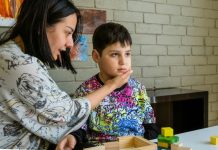
Researchers from Weill Cornell Medicine, in collaboration with other institutions, have discovered that people with autism spectrum disorder (ASD) can be divided into four subtypes based on their brain activity and behavior.
The study used machine learning to analyze neuroimaging data from 299 people with autism and 907 people without autism.
The researchers found specific patterns of brain connections that were linked to different behaviors and abilities in people with autism, such as verbal ability, social affect, and repetitive or stereotypic behaviors.
They confirmed that the four subtypes of autism could also be replicated in a separate dataset.
They showed that differences in regional gene expression and protein-protein interactions explain the brain and behavioral differences.
The researchers hope their discovery will lead to new approaches for the diagnosis and treatment of autism.
The team explained that autism is a highly heritable condition associated with hundreds of genes that has diverse presentation and limited therapeutic options.
The team identified four distinct groups of people with autism.
Two groups had above-average verbal intelligence, with one group having severe deficits in social communication but less repetitive behaviors, while the other had more repetitive behaviors and less social impairment.
The connections between the parts of the brain that process visual information were hyperactive in the subgroup with more social impairment, and weak in the group with more repetitive behaviors.
The other two groups had severe social impairments and repetitive behaviors but had verbal abilities at the opposite ends of the spectrum.
Despite some behavioral similarities, the team discovered completely distinct brain connection patterns in these two subgroups.
The researchers analyzed gene expression that explained the atypical brain connections present in each subgroup to better understand what was causing the differences.
They found that many genes previously linked with autism were involved, and analyzed network interactions between proteins associated with the atypical brain connections.
Oxytocin, a protein previously linked with positive social interactions, was a hub protein in the subgroup of individuals with more social impairment but relatively limited repetitive behaviors.
The team will next study these subgroups and potential subgroup-targeted treatments in mice.
They are also collaborating with several other research teams that have large human datasets and are working to refine their machine-learning techniques further.Top of Form
Can you prevent autism?
It is not currently known how to prevent autism spectrum disorder (ASD) because its exact cause is not yet fully understood.
However, research has shown that there are some factors that may increase the likelihood of developing ASD, such as genetic mutations and environmental exposures during pregnancy.
There is currently no medical test that can accurately predict whether a child will develop ASD.
However, early diagnosis and intervention can greatly improve outcomes and quality of life for individuals with ASD.
This includes early screening for developmental delays, as well as behavioral and educational interventions that can help with social, communication, and behavioral skills.
It is important to note that there is no evidence to support the claim that certain parenting practices, vaccines, or other external factors can cause ASD.
Therefore, efforts to prevent ASD should focus on early identification and intervention, rather than trying to avoid certain practices or exposures.
If you care about autism, please read studies about a new cause of autism, and vitamin D could help lower the risk of autoimmune diseases.
For more information about health, please see recent studies about common signs and symptoms of autism, and gut health plays a role in autism.
The study was conducted by Amanda Buch et al and published in Nature Neuroscience.
Copyright © 2023 Knowridge Science Report. All rights reserved.



